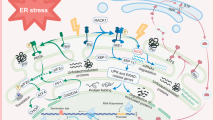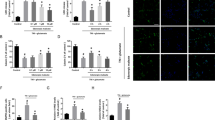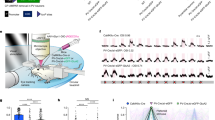Abstract
Constitutive and activity-dependent regulation of the AMPA receptor GluR2 content is recognized as an important mediator of both neuronal plasticity and vulnerability to excitotoxic neuron death. In the latter case, inclusion of GluR2 protects against glutamate excitotoxicity in CNS disease by lowering receptor single-channel conductance and preventing deleterious calcium influx. We investigated the hypothesis that aberrations in GluR2 trafficking after in vitro and in vivo cerebral trauma contribute to excitotoxicity and associated calcium-dependent cell death processes. First, in an in vitro model of traumatic brain injury (TBI), we observed PICK1 and N-methyl-D-aspartic acid (NMDA) receptor-dependent phosphorylation and internalization of GluR2. The contributing cell signaling mechanisms involved enhanced binding between PKCα (the kinase that phosphorylates GluR2) and PICK1 (its PDZ-binding partner), and a novel protein interaction between PKCα and the NMDA receptor scaffolding protein PSD-95. Functionally, these phenomena enhanced single cell AMPAR mEPSCs and protracted calcium extrusion. In vivo TBI similarly promoted GluR2 phosphorylation and internalization, with enhanced expression of calcium-permeable AMPARs in the injured hippocampus. Peptide-mediated perturbation of the PKCα/PICK1 protein interaction after trauma preserved surface GluR2 expression, attenuated AMPAR-mediated toxicity, and occluded the sensitivity of neuronal physiology to calcium-permeable AMPAR antagonists. These findings suggest that experimental TBI promotes the expression of injurious GluR2-lacking AMPARs, thereby enhancing cellular vulnerability to secondary excitotoxicity.
Similar content being viewed by others
Log in or create a free account to read this content
Gain free access to this article, as well as selected content from this journal and more on nature.com
or
Abbreviations
- AMPA:
-
alpha-amino-3-hydroxy-5-methyl-4-isoxazolepropionic acid
- PICK1:
-
protein interacting with C kinase 1
- GluR2:
-
glutamate receptor subunit 2
- NMDA:
-
N-methyl-D-aspartic acid
- p.s.i:
-
pounds per square inch
- LTD/LTP:
-
long-term depression/potentiation
- naspm:
-
1 naphthyl-acetyl spermine
- mEPSC:
-
miniature excitatory post-synaptic current
- PKCα:
-
protein kinase C α
- HBSS:
-
Hank's balanced salt solution
- D-MEM:
-
Dulbecco's modified eagle medium
- PBS:
-
phosphate buffered saline
- PSD-95:
-
post-synaptic density protein, 95 kDa
- PDZ:
-
post-synaptic density protein (PSD95)
- DlgA:
-
drosophila disc large tumor suppressor
- zo-1:
-
zonula occludens-1 protein
- TBI:
-
traumatic brain injury
References
Park E, Bell JD, Baker AJ . Traumatic brain injury: can the consequences be stopped? CMAJ 2008; 178: 1163–1170.
Ikonomidou C, Turski L . Why did NMDA receptor antagonists fail clinical trials for stroke and traumatic brain injury? Lancet Neurol 2002; 1: 383–386.
Borges K, Dingledine R . AMPA receptors: molecular and functional diversity. Prog Brain Res 1998; 116: 153–170.
Kwak S, Weiss JH . Calcium-permeable AMPA channels in neurodegenerative disease and ischemia. Curr Opin Neurobiol 2006; 16: 281–287.
Isaac JT, Ashby M, McBain CJ . The role of the GluR2 subunit in AMPA receptor function and synaptic plasticity. Neuron 2007; 54: 859–871.
Liu B, Liao M, Mielke JG, Ning K, Chen Y, Li L et al. Ischemic insults direct glutamate receptor subunit 2-lacking AMPA receptors to synaptic sites. J Neurosci 2006; 26: 5309–5319.
Noh KM, Yokota H, Mashiko T, Castillo PE, Zukin RS, Bennett MV . Blockade of calcium-permeable AMPA receptors protects hippocampal neurons against global ischemia-induced death. Proc Natl Acad Sci USA 2005; 102: 12230–12235.
Rakhade SN, Zhou C, Aujla PK, Fishman R, Sucher NJ, Jensen FE . Early alterations of AMPA receptors mediate synaptic potentiation induced by neonatal seizures. J Neurosci 2008; 28: 7979–7990.
Bell JD, Ai J, Chen Y, Baker AJ . Mild in vitro trauma induces rapid Glur2 endocytosis, robustly augments calcium permeability and enhances susceptibility to secondary excitotoxic insult in cultured Purkinje cells. Brain 2007; 130: 2528–2542.
Spaethling JM, Klein DM, Singh P, Meaney DF . Calcium-permeable AMPA receptors appear in cortical neurons after traumatic mechanical injury and contribute to neuronal fate. J Neurotrauma 2008; 25: 1207–1216.
Perez JL, Khatri L, Chang C, Srivastava S, Osten P, Ziff EB . PICK1 targets activated protein kinase Calpha to AMPA receptor clusters in spines of hippocampal neurons and reduces surface levels of the AMPA-type glutamate receptor subunit 2. J Neurosci 2001; 21: 5417–5428.
Chung HJ, Xia J, Scannevin RH, Zhang X, Huganir RL . Phosphorylation of the AMPA receptor subunit GluR2 differentially regulates its interaction with PDZ domain-containing proteins. J Neurosci 2000; 20: 7258–7267.
Leitges M, Kovac J, Plomann M, Linden DJ . A unique PDZ ligand in PKCalpha confers induction of cerebellar long-term synaptic depression. Neuron 2004; 44: 585–594.
Terashima A, Cotton L, Dev KK, Meyer G, Zaman S, Duprat F et al. Regulation of synaptic strength and AMPA receptor subunit composition by PICK1. J Neurosci 2004; 24: 5381–5390.
Terashima A, Pelkey KA, Rah JC, Suh YH, Roche KW, Collingridge GL et al. An essential role for PICK1 in NMDA receptor-dependent bidirectional synaptic plasticity. Neuron 2008; 57: 872–882.
Seidenman KJ, Steinberg JP, Huganir R, Malinow R . Glutamate receptor subunit 2 Serine 880 phosphorylation modulates synaptic transmission and mediates plasticity in CA1 pyramidal cells. J Neurosci 2003; 23: 9220–9228.
Chung HJ, Steinberg JP, Huganir RL, Linden DJ . Requirement of AMPA receptor GluR2 phosphorylation for cerebellar long-term depression. Science 2003; 300: 1751–1755.
Saglietti L, Dequidt C, Kamieniarz K, Rousset MC, Valnegri P, Thoumine O et al. Extracellular interactions between GluR2 and N-cadherin in spine regulation. Neuron 2007; 54: 461–477.
Arundine M, Aarts M, Lau A, Tymianski M . Vulnerability of central neurons to secondary insults after in vitro mechanical stretch. J Neurosci 2004; 24: 8106–8123.
Serulle Y, Zhang S, Ninan I, Puzzo D, McCarthy M, Khatri L et al. A GluR1-cGKII interaction regulates AMPA receptor trafficking. Neuron 2007; 56: 670–688.
Santos AE, Duarte CB, Iizuka M, Barsoumian EL, Ham J, Lopes MC et al. Excitotoxicity mediated by Ca2+-permeable GluR4-containing AMPA receptors involves the AP-1 transcription factor. Cell Death Differ 2006; 13: 652–660.
Lu YM, Yin HZ, Chiang J, Weiss JH . Ca(2+)-permeable AMPA/kainate and NMDA channels: high rate of Ca2+ influx underlies potent induction of injury. J Neurosci 1996; 16: 5457–5465.
Lim IA, Hall DD, Hell JW . Selectivity and promiscuity of the first and second PDZ domains of PSD-95 and synapse-associated protein 102. J Biol Chem 2002; 277: 21697–21711.
Zhang L, Rzigalinski BA, Ellis EF, Satin LS . Reduction of voltage-dependent Mg2+ blockade of NMDA current in mechanically injured neurons. Science 1996; 274: 1921–1923.
Geddes-Klein DM, Schiffman KB, Meaney DF . Mechanisms and consequences of neuronal stretch injury in vitro differ with the model of trauma. J Neurotrauma 2006; 23: 193–204.
Knapp LT, Klann E . Superoxide-induced stimulation of protein kinase C via thiol modification and modulation of zinc content. J Biol Chem 2000; 275: 24136–24145.
Knapp LT, Klann E . Potentiation of hippocampal synaptic transmission by superoxide requires the oxidative activation of protein kinase C. J Neurosci 2002; 22: 674–683.
Knapp LT, Klann E . Role of reactive oxygen species in hippocampal long-term potentiation: contributory or inhibitory? J Neurosci Res 2002; 70: 1–7.
Goforth PB, Ellis EF, Satin LS . Enhancement of AMPA-mediated current after traumatic injury in cortical neurons. J Neurosci 1999; 19: 7367–7374.
Lau A, Arundine M, Sun HS, Jones M, Tymianski M . Inhibition of caspase-mediated apoptosis by peroxynitrite in traumatic brain injury. J Neurosci 2006; 26: 11540–11553.
Ellis EF, McKinney JS, Willoughby KA, Liang S, Povlishock JT . A new model for rapid stretch-induced injury of cells in culture: characterization of the model using astrocytes. J Neurotrauma 1995; 12: 325–339.
Engel DC, Slemmer JE, Vlug AS, Maas AI, Weber JT . Combined effects of mechanical and ischemic injury to cortical cells: secondary ischemia increases damage and decreases effects of neuroprotective agents. Neuropharmacology 2005; 49: 985–995.
Nilsson P, Hillered L, Ponten U, Ungerstedt U . Changes in cortical extracellular levels of energy-related metabolites and amino acids following concussive brain injury in rats. J Cereb Blood Flow Metab 1990; 10: 631–637.
Rose ME, Huerbin MB, Melick J, Marion DW, Palmer AM, Schiding JK et al. Regulation of interstitial excitatory amino acid concentrations after cortical contusion injury. Brain Res 2002; 943: 15–22.
Soriano FX, Papadia S, Hofmann F, Hardingham NR, Bading H, Hardingham GE . Preconditioning doses of NMDA promote neuroprotection by enhancing neuronal excitability. J Neurosci 2006; 26: 4509–4518.
Dixon CE, Lyeth BG, Povlishock JT, Findling RL, Hamm RJ, Marmarou A et al. A fluid percussion model of experimental brain injury in the rat. J Neurosurg 1987; 67: 110–119.
Peterson GL . A simplification of the protein assay method of Lowry et al. which is more generally applicable. Anal Biochem 1977; 83: 346–356.
Acknowledgements
We thank Elaine Liu for technical assistance with intravenous drug injections and Kevin Park for help with mathematical integration of calcium curves. We also thank Matthew Common for technical assistance. This work was supported by funding to AJB and JDB from the Ontario Neurotrauma Foundation and the Heart and Stroke Foundation of Ontario.
Author information
Authors and Affiliations
Corresponding author
Additional information
Edited by L Greene
Rights and permissions
About this article
Cite this article
Bell, J., Park, E., Ai, J. et al. PICK1-mediated GluR2 endocytosis contributes to cellular injury after neuronal trauma. Cell Death Differ 16, 1665–1680 (2009). https://doi.org/10.1038/cdd.2009.106
Received:
Revised:
Accepted:
Published:
Issue date:
DOI: https://doi.org/10.1038/cdd.2009.106
Keywords
This article is cited by
-
Effect of multifactorial therapeutic approach on axonal regeneration and cell viability in an in-vitro model of spinal-derived neural injury
Cell and Tissue Banking (2023)
-
Neuroinflammation as an etiological trigger for depression comorbid with inflammatory bowel disease
Journal of Neuroinflammation (2022)
-
Exo70 intracellular redistribution after repeated mild traumatic brain injury
Biological Research (2021)
-
Cortactin regulates endo-lysosomal sorting of AMPARs via direct interaction with GluA2 subunit
Scientific Reports (2018)
-
DR-region of Na+/K+ ATPase is a target to treat excitotoxicity and stroke
Cell Death & Disease (2018)



